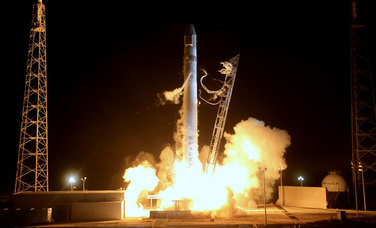Team Penske Team Members Move from Space to Race
June 5, 2020
"Penske Material" provides an inside look at some of the personalities, stories and moments that make Team Penske so unique.
When a race car is engineered and run to perfection by a team, it’s considered to be a “rocket ship” on track. For two members of Team Penske, that term carries an even deeper meaning because they have worked with real rocket ships before they transitioned from space to race in the team’s NASCAR program.
 Both Andrea Mueller, race engineer on the No. 2 Ford Mustang driven by Brad Keselowski in the NASCAR Cup Series and Matt Swiderski, crew chief of Team Penske’s No. 12 Xfinity Series Ford Mustang team, have extensive engineering backgrounds and they’ve worked on some the most technologically-advanced advanced rockets before shifting their focus to create the fastest racecars in NASCAR.
Both Andrea Mueller, race engineer on the No. 2 Ford Mustang driven by Brad Keselowski in the NASCAR Cup Series and Matt Swiderski, crew chief of Team Penske’s No. 12 Xfinity Series Ford Mustang team, have extensive engineering backgrounds and they’ve worked on some the most technologically-advanced advanced rockets before shifting their focus to create the fastest racecars in NASCAR.
 In Mueller’s former career as a rocket scientist, the Fresno, Calif., native worked as a Space Shuttle Main Engine (SSME) nozzle development engineer from August 2003 to January 2007. The SSMEs are the big cone nozzles that are located on the back of a space shuttle. Mueller’s work focused on pre-existing nozzles, determining the best way to repair damaged nozzles already flown and prepare them to fly again. This involved working with a team to identify the issue with the nozzle, determine how it got damaged, develop a plan to repair it, present those plans to NASA, work with the shop to implement the plan and test the nozzle to verify its flight worthiness after repair.
In Mueller’s former career as a rocket scientist, the Fresno, Calif., native worked as a Space Shuttle Main Engine (SSME) nozzle development engineer from August 2003 to January 2007. The SSMEs are the big cone nozzles that are located on the back of a space shuttle. Mueller’s work focused on pre-existing nozzles, determining the best way to repair damaged nozzles already flown and prepare them to fly again. This involved working with a team to identify the issue with the nozzle, determine how it got damaged, develop a plan to repair it, present those plans to NASA, work with the shop to implement the plan and test the nozzle to verify its flight worthiness after repair.
 Swiderski briefly stepped away from racing in 2012 to join Space Exploration Technologies (SpaceX), founded by Elon Musk. Swiderski worked on various projects at SpaceX, including the development and implementation of a multibody simulation to predict landing loads for the Grasshopper Spacecraft. The Grasshopper was a rocket built to test methods of landing a first stage rocket. Swiderski created a simulation to predict rocket loads for landing conditions such as wind speed direction, rocket speed tilt and landing surface type. He also helped develop a landing leg deployment simulation for the Falcon 9 v1.1, the production version of the rocket that is still utilized by SpaceX today. It became the first production rocket that SpaceX was able to re-use for the first stage across multiple missions.
Swiderski briefly stepped away from racing in 2012 to join Space Exploration Technologies (SpaceX), founded by Elon Musk. Swiderski worked on various projects at SpaceX, including the development and implementation of a multibody simulation to predict landing loads for the Grasshopper Spacecraft. The Grasshopper was a rocket built to test methods of landing a first stage rocket. Swiderski created a simulation to predict rocket loads for landing conditions such as wind speed direction, rocket speed tilt and landing surface type. He also helped develop a landing leg deployment simulation for the Falcon 9 v1.1, the production version of the rocket that is still utilized by SpaceX today. It became the first production rocket that SpaceX was able to re-use for the first stage across multiple missions.
Swiderski also created a MATLAB-based simulation to help determine which point of the landing stage to deploy the rocket’s landing legs in order to maintain an acceptable load level and minimize the required helium supply for deployment. He also helped design, build, program and utilize a data acquisition system for the transport of rocket stages from the SpaceX factory in Hawthorne, Calif., to its test facility in MacGregor, Tex., and then to the launch pad in Cape Canaveral, Fla. Once the data system was operational, Swiderski would travel with the rocket for the first few trips to download and analyze the data each evening after a day of driving. This created a unique challenge because rockets travelling on their side down the interstate create a completely different load case than the vertical flight paths they are originally designed for. Swiderski served as a mission control support representative for the program’s COTS-2 mission. His role for the mission was to analyze how the weather was going to affect the predicted loads on the rocket. The operations group at Cape Canaveral would release weather balloons at various increments leading up to the launch. Swiderski would combine the data with the flight path from the Guidance, Navigation, and Control Group and give a go or no go for launch from the Dynamics Group.
 Both Mueller and Swiderski studied mechanical engineering and their respective classes were centered around STEM (Science, Technology, Engineering, Mathematics) applications that are used almost daily in racing and rocket science. “The STEM side of our sport is what attracted me to the sport to begin with.” Swiderski said. “I’ve always been interested in cars, but there is no better form of competitive STEM than motorsports. Even before I knew I was going to have a career in motorsports, I knew I wanted to work on and design cars. The ability to combine the use of STEM in a competitive sense is what drew me back to NASCAR and keeps me there. The technology of SpaceX was amazing, and it was a challenging, fast-paced environment. The one thing that I missed (about motorsports) was the competitive side. We were competing to come to market with a private, reusable launch system before anyone else but we weren’t able to directly line up against our competitors every weekend to see who solved the problem the best like you can in motorsports.”
Both Mueller and Swiderski studied mechanical engineering and their respective classes were centered around STEM (Science, Technology, Engineering, Mathematics) applications that are used almost daily in racing and rocket science. “The STEM side of our sport is what attracted me to the sport to begin with.” Swiderski said. “I’ve always been interested in cars, but there is no better form of competitive STEM than motorsports. Even before I knew I was going to have a career in motorsports, I knew I wanted to work on and design cars. The ability to combine the use of STEM in a competitive sense is what drew me back to NASCAR and keeps me there. The technology of SpaceX was amazing, and it was a challenging, fast-paced environment. The one thing that I missed (about motorsports) was the competitive side. We were competing to come to market with a private, reusable launch system before anyone else but we weren’t able to directly line up against our competitors every weekend to see who solved the problem the best like you can in motorsports.”
 Mueller has been on a steady climb in NASCAR since relocating to North Carolina. She joined Team Penske in 2007 as an engineer and implemented programs to reduce car weight, enhance data acquisition and improve radio communications. Now, as race engineer for Keselowski, crew chief Jeremy Bullins relies on Mueller for fuel mileage calculations, which involves monitoring the teams’ mileage as conditions change during a race. The calculations determine when the No. 2 Ford Mustang needs to pit for fuel and how much gas it needs to make it to the end of the race. Mueller is also responsible for gathering and prioritizing historical race information to help Bullins make informed decisions on car step-up and pit strategy. Muller has also developed and presented new ideas for car setups and other techniques to help improve the car’s speed and performance.
Mueller has been on a steady climb in NASCAR since relocating to North Carolina. She joined Team Penske in 2007 as an engineer and implemented programs to reduce car weight, enhance data acquisition and improve radio communications. Now, as race engineer for Keselowski, crew chief Jeremy Bullins relies on Mueller for fuel mileage calculations, which involves monitoring the teams’ mileage as conditions change during a race. The calculations determine when the No. 2 Ford Mustang needs to pit for fuel and how much gas it needs to make it to the end of the race. Mueller is also responsible for gathering and prioritizing historical race information to help Bullins make informed decisions on car step-up and pit strategy. Muller has also developed and presented new ideas for car setups and other techniques to help improve the car’s speed and performance.
From an engineering standpoint, Mueller and Swiderski said there are numerous similarities between working on racecars and rockets. Both are high-performance machines that require reliable equipment to perform under pressure to produce a successful result. “I think the biggest carryover is the technical problem solving. I am continuously faced with technical challenges and I must figure out how to work with others to solve problems.” Mueller said. “I am able to lean on that experience when new projects or issues arise at Team Penske. The biggest similarity between working at Rocketdyne and Penske is there is no room for error. Both require great attention to detail in the prep work going into a launch or race.”
Swiderski said his eighth months away from racing gave him a new perspective and appreciation for some of NASCAR’s subtleties.
“By the time I went to SpaceX, I had already spent seven years in motorsports. So it was interesting to see the new approaches to engineering problems,” said Swiderski. “Joining SpaceX exposed me to new methods of solving similar engineering problems. I think learning new techniques to analyze large amounts of data efficiently is an area that I was able to directly apply when I came back to motorsports. As NASCAR regulations tighten, the window that teams have to operate each year, while at the same time open up channels for increased data, the importance on being able to quickly analyze the data and make decisions becomes increasingly important, the difference between successful and unsuccessful teams. My time in mission control, though limited, also gave me new perspective on team communication and communication technology. As NASCAR teams move towards more support from the shop, the mission control room and team strategy/war room become quite similar.”
Whether it’s preparing a rocket for space or preparing to go win a race, both Mueller and Swiderski have proven they have the knowledge, experience, and skill sets to deliver and reach new heights with Team Penske.
More Penske Material
Read more about the personalities, stories and moments that make Team Penske unique.

